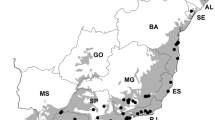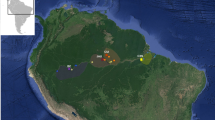Abstract
With 2285 species of higher plants crammed into 471 km2, the flora of South Africa's Cape Peninsula is exceptionally rich. Similar sized areas in other Mediterranean-climate region biodiversity hot-spots support between 4.7 and 2.7 times fewer species. The high plant species richness of the Cape Peninsula is due to the exceptionally high turnover between moderately species-rich sites in different habitats (beta diversity) and between sites in similar habitats along geographical gradients (gamma diversity). Highest beta diversity, encompassing almost complete turnover, was recorded along soil fertility gradients. Although similar patterns for these independent components explain the richness of other regions in the Cape Floristic Region, it is the very long and steep habitat gradients of the Cape Peninsula that makes this region exceptionally rich. Furthermore, the flora is characterized by a high degree of rarity, a phenomenon that undoubtedly influences the turnover. Future research should focus on developing a biological and ecological understanding of the different forms of rarity and integrating this into management plans for the maintenance of biodiversity.
Similar content being viewed by others
References
Arroyo, M.T.K., Cavieres, L., Maticorena, C. and Munoz-Schlick, M. (1995) Convergence in the Mediterranean floras in central Chile and California: insight from comparative biogeography. In Ecology and Biogeography of Mediterranean Ecosystems in Chile, California and Australia (M.T.K. Arroyo, M. Fox and P. Zedler, eds) pp. 43–88. Berlin: Springer Verlag.
Baev, P.V. and Penev, L.D. (1993) Biodiv: Program for Calculating Biological Diversity Parameters, Similarity, Niche Overlap and Cluster Analysis. Sofia: Pensoft.
Bond, W.J. (1983) On alpha diversity and richness of the Cape flora: a study in southern Cape fynbos. In Mediterranean-type Ecosystems: the Role of Nutrients (F.J. Kruger, Mitchell, D.T. and J.U.M. Jarvis, eds) pp. 337–56. Berlin: Springer Verlag.
Bond, W.J. (1988) Proteas as ‘tumble weeds’: wind dispersed through air and over soil. S. Afr. J. Bot. 54, 455–60.
Bond, W.J. and van Wilgen, B.W. (in press) Fire and Plants. London: Chapman and Hall.
Bond, W.J., Vlok, J. and Viviers, M. (1984) Variation in seedling recruitment of Cape Proteaceae after fire. J. Ecol. 72, 209–21.
Bond, W.J., Le Roux, D. and Erntzen, R. (1990) Fire intensity and regeneration of myrmecochorous Proteaceae. S. Afr. J. Bot. 56, 326–30.
Brown, J.H. (1988) Species diversity. In Analytical Biogeography. An Integrated Approach to the Study of Animal and Plant Distributions (A.A. Myers and P.S. Giller, eds) pp. 57–89. London: Chapman and Hall.
Campbell, B.M. (1986) Montane plant communities of the fynbos biome. Vegetatio 66, 3–16.
Campbell, B.M. and Moll, E.J. (1977) The forest communities of Table Mountain, South Africa. Vegetatio 34, 105–15.
Cody, M.L. (1986) Diversity, rarity and conservation in Mediterranean-climate regions. In Conservation biology. The science of scarcity and diversity (M.E. Soule, ed.) pp. 122–52. Sunderland, Massachusetts: Sinauer Associates.
Cody, M.L. (1993) Bird diversity components within and between habitats in Australia. In Species Diversity in Ecological Communities: Historical and Geographical Perspectives (R.E. Ricklefs and D. Schluter, eds) pp. 350–63. Chicago: University of Chicago Press.
Cowling, R.M. (1983a) Diversity relations in Cape shrublands and other vegetation in the southeastern Cape, South Africa. Vegetatio 54, 103–27.
Cowling, R.M. (1983b) Phytochorology and vegetation history in the south eastern Cape, South Africa. J. Biogeogr. 10, 393–419.
Cowling, R.M. (1987) Fire and its role in coexistence and speciation in Gondwanan shrublands. S. Afr. J. Sci. 83, 106–12.
Cowling, R.M. (1990) Diversity components in a species-rich area of the Cape Floristic Region. J. Vegetation Sci., 1, 699–710.
Cowling, R.M. and Gxaba, T. (1990) Effects of a fynbos overstorey shrub on understorey community structure: implications for the maintenance of community-wide species richness. S. Afr. J. Ecol. 1, 1–7.
Cowling, R.M. Holmes, P.M. and Rebelo, A.G. (1992) Plant diversity and endemism. In The Ecology of Fynbos. Nutrients Fire and Diversity (R.M. Cowling, ed.) pp. 62–112. Cape Town: Oxford University Press.
Cowling, R.M., Macdonald, I.A.W. and Simmons, M.T. (1996) The Cape Peninsula, South Africa: physiographical, biological and historical background to an extraordinary hot-spot of biodiversity. Biodiv. and Conserv. 5, 527–50.
Cowling, R.M., Richardson, D.M., Schulze, R.E., Hoffman, M.T., Midgley, J.J. and Hilton-Taylor, C. (in press) Species diversity at the regional scale. In Vegetation of Southern Africa (R.M. Cowling and D.M. Richardson, eds). Cambridge: Cambridge University Press.
Diamond, J.M. (1988) Factors controlling species diversity: overview and synthesis. Ann. Missouri Bot. Garden 75, 117–29.
Esler, K.J. and Cowling, R.M. (1990) The effects of density on the reproductive output of Protea lepidocarpodendron. S. Afr. J. Bot. 56, 29–33.
Glyphis, J., Moll, E.J. and Campbell, B.M. (1978) Phytosociological studies on Table Mountain, South Africa: 1. The Back Table. J. S. Afr. Bot. 44, 281–9.
Graham, R.W. (1988) The role of climatic change in the design of biological reserves. The paleoecological perspective for conservation biology. Conserv. Biol. 2, 391–4.
Hunter, M.L., Jacobsen, G.L. and Webb, T. (1988) Paleoecology and the coarse-filter approach to maintaining biological diversity. Conserv. Biol. 2, 375–85.
Joubert, C. and Moll, E.J. (1992) A phytosociological study of Signal Hill, Cape Town, utilizing both perennial and ephemeral species. Bothalia 22, 255–82.
Kruger, F.J. (1974) The Physiography and Plant Communities of Jakkalsrivier Catchment. MSc Thesis. University of Stellenbosch.
Kruger, F.J. and Taylor, H.C. (1979) Plant species diversity in Cape fynbos: gamma and delta diversity. Vegetatio 47, 85–93.
Laider, D., Moll, E.J., Campbell, B.M. and Glyphis, J. (1978) Phytosociological studies on Table Mountain, South Africa: 2. The Front Table. J. S. Afr. Bot. 44, 291–5.
Le Maitre, D.C. (1987) Effects of season of burn on species populations and composition of fynbos in the Jonkershoek valley. S. Afr. J. Bot. 53, 284–92.
Levyns, M.R. (1964) Migrations and origin of the Cape Flora. Trans. Roy. Soc. S. Afr. 37, 85–107.
Linder, H.P., Meadows, M.E. and Cowling, R.M. (1992) History of the Cape Flora. In The Ecology of Fynbos. Nutrients Fire and Diversity (R.M. Cowling, ed.) pp. 113–34. Cape Town: Oxford University Press.
MacDonald, D.J., Juritz, J.M, Cowling, R.M. and Knotterbelt, W.J. (in press) Modelling the biological aspects of local endemism in South African fynbos. Plant Syst. Evol.
McKenzie, B., Moll, E.J. and Campbell, B.M. (1977) A phytosociological study of Orange Kloof, Table Mountain, South Africa. Vegetatio 34, 1–53.
Magurran, A.E. (1988) Ecological Diversity and its Measurement. London: Croom Helm. 179 pp.
Midgley, J., Seydack, A. and Van Wyk, G.F. (in press) Forest biome. In Vegetation of Southern Africa (R.M. Cowling and D.M. Richardson, eds). Cambridge: Cambridge University Press.
Mustart, P.J. and Cowling, R.M. (1993) The role of regeneration stages in the distribution of edaphically restricted fynbos Proteacae. Ecology 74, 1490–9.
Myers, N. (1990) The biodiversity challenge: expanded hot-spot analysis. Environmentalist 8, 1–20.
Oliver, E.G.H., Linder, H.P. and Rourke, J.P. (1983) Geographical distribution of present day Cape taxa and their phytogeographical significance. Bothalia 18, 1–10.
Rabinowitz, D., Cairns, S. and Dillon, T. (1986) Seven forms of rarity and their frequency in the flora of the British Isles. In Conservation Biology: the Science of Scarcity and Diversity (M. Soule, ed.) pp. 182–204. Sunderland, Massachusetts: Sinauer Associates Inc.
Richards, M.B. (1993) Soil Factors and Competition as Determinants of Fynbos Plant Species Distributions in South-western Cape, South Africa. MSc thesis, University of Cape Town.
Richards, M.B., Cowling, R.M. and Stock, W.D. (submitted) Plant communities and vegetation-environment relationships in species-rich fynbos of the Soetanysberg Hills, South Africa. S. Afr. J. Bot.
Richardson, D.M., van Wilgen, B.W., Higgins, S.I., Trinder-Smith, T.H., Cowling, R.M. and McKelly, D.H. (1996) Current and future threats to plant biodiversity on the Cape Peninsula, South Africa. Biodiv. Conserv. 5, 607–47.
Ricklefs, R.E. (1987) Community diversity: relative roles of local and regional processes. Science 235, 167–71.
Ricklefs, R.E. and Schluter, D. (1993) Species diversity: regional and historical influences. In Species Diversity in Ecological Communities: Historical and Geographical Perspectives (R.E. Ricklefs and D. Schluter, eds) pp. 350–63. Chicago: University of Chicago Press, Chicago.
Rosenzweig, M.L. (1992) Species diversity gradients: we know more and less than we thought. J. Mammalogy 73, 715–30.
Rosenzweig, M.L. and Abramsky, Z. (1993) How are diversity and productivity related? In Species Diversity in Ecological Communities: Historical and Geographical Perspectives (R.E. Ricklefs and D. Schluter, eds) pp. 52–65. Chicago: University of Chicago Press.
Shmida, A. and Wilson, M.V. (1985) Biological determinants of species diversity. J. Biogeogr. 12, 1–20.
Takhtajan, A. (1986) Floristic Regions of the World. Berkeley: University of California Press.
Taylor, H.C. (1969) A vegetation survey of the Cape of Good Hope Reserve. MSc thesis, University of Cape Town.
Tilman, D. and Pacala, S. (1993) The maintenance of species richness in plant communities. In Species Diversity in Ecological Communities: Historical and Geographical Perspectives (R.E. Ricklefs and D. Schluter, eds) pp. 13–25. Chicago: University of Chicago Press.
Trinder-Smith, T.H., Cowling, R.M. and Linder, H.P. (1996) Plant endemism in the Cape Peninsula, South Africa: an analysis. Biodiv. Conserv. 5, 575–89.
Whittaker, R.H. (1972) Evolution and measurement of species diversity. Taxon 21, 213–51.
Whittaker, R.H. (1977) Evolutions of species diversity in land communities. Evol. Biol. 10, 1–67.
Williamson, M. (1988) Relationship of species number to area, distance and other variables. In Analytical Biogeography, An Integrated Approach to the Study of Animal and Plant Distributions (A.A. Myers and P.S. Giller, eds) pp. 91–115. London: Chapman and Hall.
Wilson, M.V. and Shmida, A. (1984) Measuring beta diversity with presence-absence data. J. Ecol. 72, 1055–64.
Wright, D.H., Currie, D.J. and Maurer, B.A. (1993) Energy supply and patterns of species richness on local and regional scales. In Species Diversity in Ecological Communities: Historical and Geographical Perspectives (R.E. Ricklefs and D. Schluter, eds) pp. 66–74. Chicago: University of Chicago Press.
Author information
Authors and Affiliations
Rights and permissions
About this article
Cite this article
Simmons, M.T., Cowling, R.M. Why is the Cape Peninsula so rich in plant species? An analysis of the independent diversity components. Biodivers Conserv 5, 551–573 (1996). https://doi.org/10.1007/BF00137609
Received:
Accepted:
Issue Date:
DOI: https://doi.org/10.1007/BF00137609




